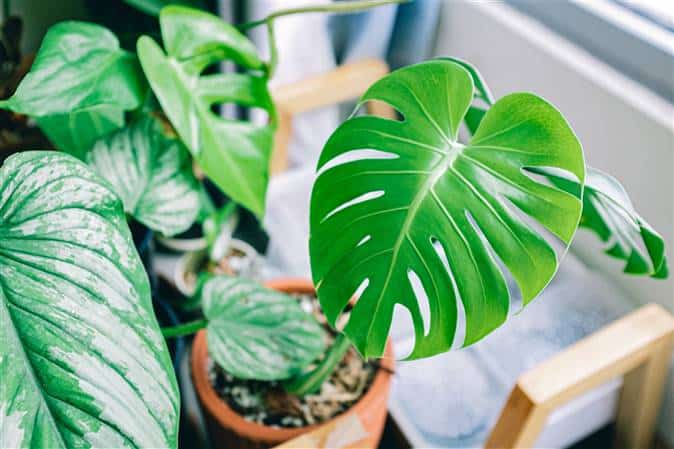If you are looking for a striking houseplant that does not require much attention and brings a powerful tropical vibe to your home, then monstera deliciosa is the right choice!
Monstera’s distinctive greenery and unique foliage with recognizable, extravagant slits will ennoble any space, from the living room to the office or hotel lounges. And, indeed, it does not require any special attention!
What is Monstera Deliciosa
Monstera deliciosa is a long-lived, flowering, creeping perennial from the eponymous genus of plants from the Araceae family.
The genus includes 45 epiphytic plants native to the tropical forests of South America, which were brought to Europe by Spanish invaders in the late 16th century.
Unlike that time, when monstera deliciosa was an exotic rarity available only to the privileged, today, this is a ubiquitous ornamental plant worldwide.
The name Monstera comes from the Latin word monster suggesting its enormous leaf size. Besides its botanical name, the plant is known as the Swiss cheese plant due to its perforated foliage.
Sometimes you can find it by the name Split-leaf philodendron because of its similarity to philodendron, a plant from the same family but a different genus.
Monstera Deliciosa Leaves
The trademark of Monstera is its large, shiny dark green, heart-shaped, perforated, or pinnately divided leaves. The remarkable leaves grow on elegant long stalks that extend in all directions.
In the natural environment, each leaf can grow up to 3 feet in length and two feet in width! Yet, the leaves of home-grown plants have more modest dimensions reaching 2 feet maximum.
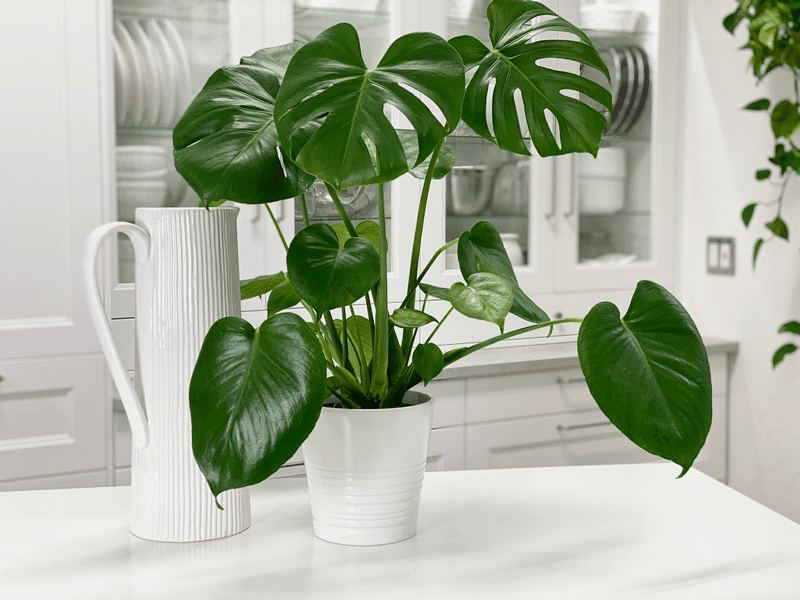
Young leaves are entire, light green without holes and slits! As they grow, unusual holes arranged along the central vein appear. The holes expand to the edges as the leaf matures, making the adult leaves look like rakes.
Interestingly, these slits are not just a decoration or a whim of Mother Nature. Heavy and frequent tropical rains, often accompanied by a stormy wind, easily pass-through holes and slits in the leaves.
Due to them, the impact surface of the leaves is much smaller, which reduces possible damage. In addition, perforated leaves dry faster after rain and are harder to break in the wind.
Monstera Deliciosa Growing Habit
Young Monstera deliciosa is a self-standing plant. However, the central stem shows creeping tendencies, after the first few leaves develop. In nature, the plant will crawl along the trunks of high tropical vegetation. Indoors, you need to provide it with support such as a moss pole.
With time, from two feet tall beauty, which is usually the size of plants sold in horticulture, the plant can grow into monsters 10 to 15 feet tall and 8 feet wide!
The plant’s annual growth is one to two feet, so before you bring it home enthusiastically, provide it with enough space to grow unhindered.
Monstera Deliciosa Areal Roots
To attach to the host, monstera deliciosa, like other epiphytic plants, develops aerial roots – the specialized, multi-functional organs.
First, the aerial roots serve as a grip that gives the plant stability and keeps it clinging to the host or support.
Then, as the plant grows, the leaf mass moves away from the root that feeds it, so the aerial roots collect moisture from the environment, providing additional water.
The aerial roots initially look like nodules growing out of the stem’s nodes, which elongate, and over time they can reach several feet.
Yet, do not remove these strange growths! In addition to being functional, they contribute to its jungle-like, natural appearance.
Monstera Deliciosa Flowers and Fruits
All plants of the Araceae family have characteristic calla-like blooms with a large light green or white bract that envelops the piston flower. In nature, wild monstera deliciosa can bloom at any time of the year, provided they are mature enough.
However, flowering is sporadic in indoor conditions, and if it does occur, it is usually in the summer period.
Suppose you wonder why this species has the epithet ‘deliciosa,’ suggesting something tasty and edible in its name. In that case, the answer is simple! The fruits of this plant are edible and have pleasant pineapple or mango flavor.
They develop from pollinated flowers, and when ripe, they have a lovely fruity scent.
Monstera Deliciosa Toxity
One disliked fact for members of the Araceae family from which many beautiful houseplants come is that they are poisonous plants.
Monstera deliciosa is no exception. Its leaves contain calcium oxalate, a toxic substance that can cause skin irritation or digestive problems if it enters the digestive tract. However, this information did not affect the incredible popularity of this plant.
As we have already said, deliciosa refers to its fruits which are the only non-toxic part of the plant, and not to its gorgeous foliage! Therefore, it is unlikely that even your pets will want to bite its leaves!
And when it comes to skin irritation, gloves solve the problem when handling the plant.
How to Care for Monstera Deliciosa
Even when you do not have much experience growing tropical plants, you can effortlessly host this adaptable and undemanding jungle-like beauty in your home. Its modest needs are easy to meet, and if you are unsure what conditions to provide, here are some elementary tips for monstera’s growing.
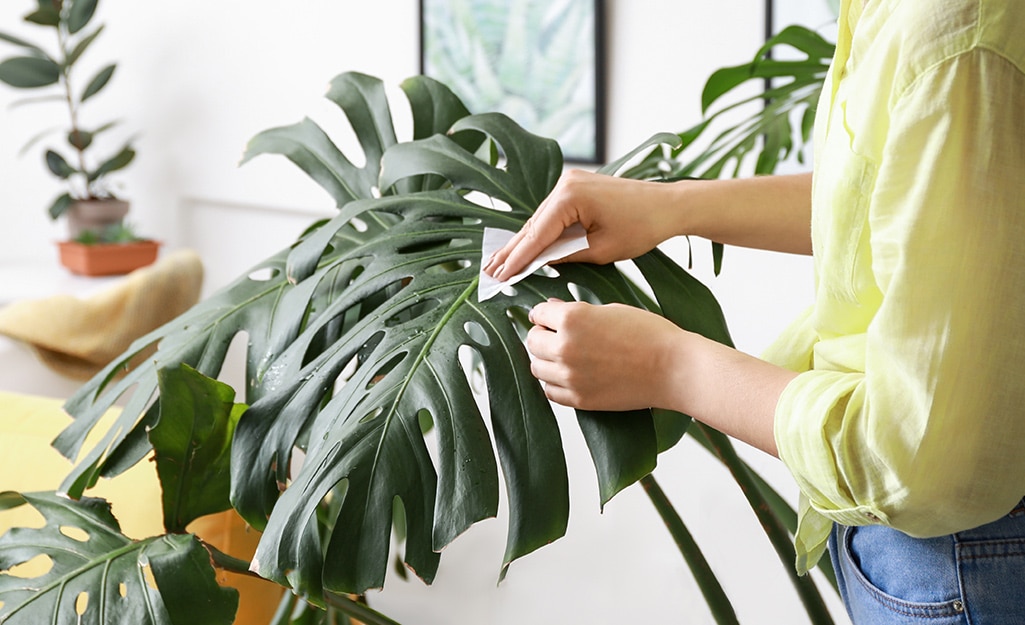
Light
You can often read that monstera deliciosa is a very adaptable plant to various light conditions, and even that is great for low-light spaces.
However, such information is only partially correct. The plant can survive the low light, but there is a big difference between surviving and thriving.
Therefore, if you want a lush, robust, impressive plant like the one you see on Instagram, provide it with a lot of filtered, indirect light. Ideal positions are by the east or west window, even with some mild direct morning or afternoon sun.
Move it at least 6 feet away from the south window or shade the window with a curtain! Remember that this is a plant that grows in the shade of high tropical canopies so the direct midday sun causes burns on the leaves.
If you have no other option, you can place it next to the north window. Yet, you have to consider that the plant might become sparsely, leggy and distorted towards the light source. Too shady room usually causes plant’s slow growth and smaller leaves.
Water
In the intensive growth phase, you can water monstera deliciosa once in fifteen days with lukewarm stagnant water from spring to autumn.
The watering schedule depends on other factors, such as exposure to light, soil composition, size of the plant, and pot size. Therefore, it is best to allow the substrate to dry before watering again.
Excess water is a bigger problem than the lack of water because the plant can partially compensate for it through the aerial root. On the other hand, soaked soil causes root rot, a disorder that is difficult to repair!
Humidity
An average home humidity level of 30 or 40% is enough to make your Monstera feel comfortable. If the value is below the above, you can occasionally spray the leaves using a fine atomizer that turns water into a mist.
Regularly wiping the leaves with a damp cloth is also one of the ways to provide the plant with a little extra moisture. In addition, removing dust opens the leaves pores so the plant breathes easier and, of course, looks nicer and tidier.
Speaking of leaf care, let’s mention an old trick! When you wipe the dust, coat the leaves with a banana peel. This treatment ‘feeds’ the leaves, has an antistatic effect, and provides additional shine to the leaves.
Soil
Monstera prefers airy, well-drained, and nutritious soil with a slightly acidic ph reaction of 5, 5, to 7.
The best option for growing Monstera deliciosa is a ready-made, peat-based mixture for tropical plants that you can purchase in every better-equipped garden center.
Yet, if you cannot find such a substrate, you should not give up growing this gorgeous plant.
Alternatively, you could make a homemade mixture with standard houseplant substrate, perlite, and coconut choir in equal proportions.
To increase the airiness of the bland, you can also add a handful of mixture for cacti or orchid bark. It is essential that the substrate is not too compacted and drains quickly and easily.
Temperature
Since monstera deliciosa comes from a warm climate zone with no large temperature oscillations, it grows best at a uniform temperature of 60 to 80 F.
Fortunately, this is the standard temperature of our living and working space, so the monstera feels comfortable where you do the same way.
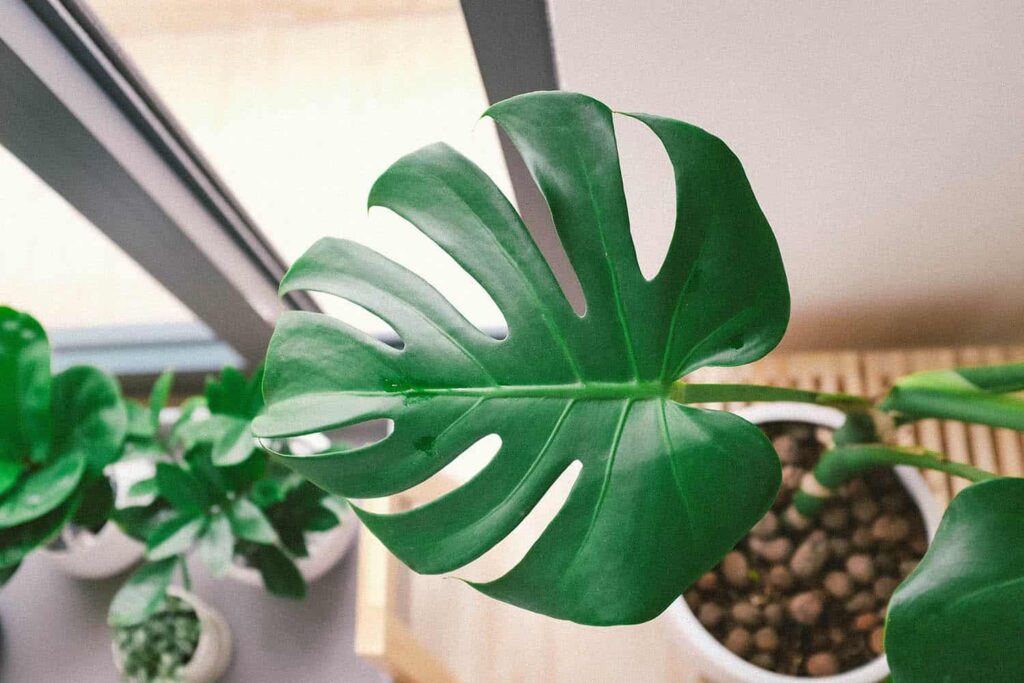
The lower minimum that the plant can withstand is 55 F, and in a short period, up to 50 F. It is sensitive to sudden temperature differences, cold air currents, and drafts. Therefore, place it where there is not much difference between day and night temperature, especially in winter.
During the warm summer months, you can take your young monstera outside but not to the blazing sun. The shaded part of the yard or terrace is an ideal place.
However, as soon as the night temperature drops below 55 F, return it to the safe warmth of home.
Repotting of Monstera Deliciosa
Young monsteras usually come in pots 6 to 8 inches in diameter. The plant can remain in that pot until part of the root emerges through the drainage openings.
When you notice tiny protruding veins, it signifies that the plant needs new, more extensive accommodation. Although you can transplant your monster at any time of the year, it is the best to do it in early spring, before the plant develop new leaves after winter dormancy.
The new container should be just two or three inches larger than the previous one. In an oversized pot, the plant will focus its energy on root development instead of leaf mass!
Soon or later your monstera will grow few feet high end up in a large pot. Repotting such a big plant can be a challenging endeavor and you can’t change the container indefinitely for a bigger and bigger one!
In that case, instead of transplanting such a big plant, you should replace the top two or three inches layer of the substrate with the fresh one.
Monstera Deliciosa Fertilizer
If you have planted the Monstera Deliciosa in quality, nutritious soil, the plant will need sporadic additional nutrition.
Generally, you should not feed it more than once a month, from spring to autumn, using liquid fertilizer dissolved in water. It is best to choose a fertilizer with an N: P: K ratio of 3: 2: 1 since it stimulates lush growth due to the high nitrogen content.
And one more warning: First, water the plant with plain water. Then, wait an hour for the substrate to drain, and only then add the nutrient solution as fertilizing on dry soil can damage the root system.
In early October you could cut off extra feeding. It is the time when the plant enters the dormant phase.
Another option is granular, slow-release fertilizer that you can bury in the substrate at the beginning of the season. In doing so, always follow the instructions on the package because too many nutrients do more harm than good.
Monstera deliciosa Propagationion
The easiest way to propagate monstera is top cuttings taken in spring. All you need for this simple three-step process are sharp, sterilized scissors or a knife, a water vase, and, of course, a well-branched monstera plant.
- Step 1: Choose a healthy branch with one or more leaves.
- Step2: Cut the stem one inch below the node so that the cutting has a leaf and aerial roots. A leaf with a stalk without a stem with a node cannot develop a root, but the top of a stem that has a node can, even without leaves!
- Step3: Put the cuttings in a deeper vase with water. If the vase is transparent, you will be able to follow the development of the roots under the nude.
The rooting process takes about two to three weeks, after which the baby monster is ready to be transplanted into a pot with the substrate.
And do not be afraid that taking cuttings will harm the mother plant. Just the opposite! Cutting the top branches stimulates new growth and allows you to control the size or shape of the plant.
Monstera Deliciosa Problems
When grown in optimal conditions, monstera deliciosa is a hardy and resistant plant that’s not prone to diseases. If some of the cultivated factors ate under fair values, it could lead to the development of the disease. Here are the most characteristic ones:
Leaf spot
Leaf spot is a common disease caused by fungi. It is easily transmitted from other species nearby. Stagnant air, warm weather, and high humidity increase the possibility of infection.
The first symptoms are yellow or brown spots on parts of the leaf. Gradually, they increase and can lead to falling off over time.
As soon as you notice these changes in the foliage, cut off all infected leaves immediately. Reduce watering and completely stop spraying the leaves. Move the plant to a brighter or more airy place since the fungus does not tolerate air circulation among the leaves.
If none of the above helps, you still have the option of the chemical fungicide treatment. It as an effective, fast, and harmless way to stop the spread of the disease.
Root rot
Unfortunately, root rot often occurs due to excessive watering or impermeable substrate. As a result, the infected rootball is brown and has an unpleasant odor of decay even after rinsing.
You can solve this problem by removing diseased parts leaving only solid and healthy components. For example, the plant will survive if you remove two-thirds of its root ball, but in that case, you must cut the aboveground part as well.
Pests
In general, monstera deliciosa is resistant to pests, but that does not mean that these little intruders will not try to settle on your plant. We bring below how to spot them and get rid of them.
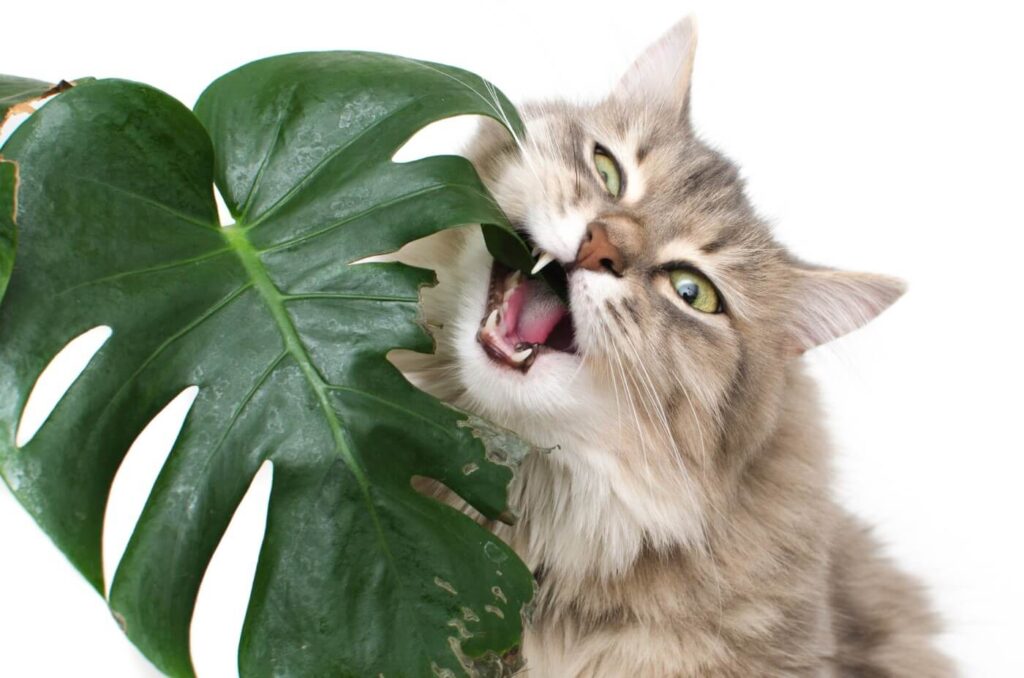
Spider mites
Spider mites are small, reddish, hard-to-see insects that hide on the back of the leaf and feed on plant juices. They appear more often in a room with dry air. You will notice its presence due to curling leaves, yellow spots on the leaf reverse, and a fine red net among the leaves.
If you do not want to use industrial, chemical insecticides, the natural solution is essential pine or neem oil. You could apply it by wiping the leaves from both sides.
However, as these are very tiny creatures, you usually need to repeat the process several times before finally getting rid of them.
Aphids
Aphids are common parasites transmitted from one plant to another. They are tiny insects that appear at the junction of leaves and stems and live in colonies.
They also feed on plant juices, cause leaf curl, and leave drops of sweet liquid that can contribute to disease infection.
Here, neem oil can help too! But if you don’t have neem oil on hand, you could mist the plant with chilled nettle tea!
Conclusion
Few plants can instantly transform your living or working room into a green oasis with the irresistible charm of a tropical atmosphere. Monstera deliciosa is the one!
It may take space but, growing this plant does not take your time! With its modest needs, it perfectly follows the rhythm of modern life and can withstand even occasional neglect.
It fits almost any interior and what is more important, never go unnoticed!

